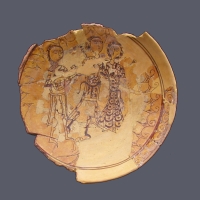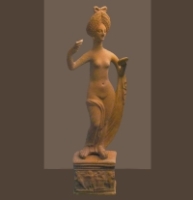|
Messembria continued trading, minting coins, developing local crafts during the Roman reign. The pottery covered with red varnish, the marble funeral gravestones and the votive reliefs of Hercules and the Thracian Horseman are all dated back to this epoch. Another monument of interest is the marble pedestal for a bronze statue of Claudius I (AD 41-54) placed there by Gneus, son of Gneus, the town gymnasiarch.
After the division of the Roman Empire in AD 395, Messembria remained within its Eastern part. The town acquired growing significance as a strategic, economic and cultural centre in close connection to the Byzantine capital Constantinople. Massive defences and vast Christian basilicas were built. Sealed bricks bearing the names of Constantine and Justinian were made in the brickworks of the Byzantine capital. Marble foundations, columns, capitals of various kinds, parts of altar partitions as well as other elements belonging to the internal plastic decoration of the buildings were made and imported from the isle of Prokonissos in the Sea of Marmara.
With the establishment of the Bulgarian State in 7th century, Messembria turned into a significant military fortress of the Byzantine Empire against her new neighbour. It was not earlier than 812 that the town was conquered by Bulgarian Khan Kroum and included within the First Bulgarian State. The pottery made of grey clay are the material vestiges left by the first Bulgarian inhabitants of the peninsula.
The collection of amphorae and white-clay glazed vessels exhibited in the hall funish proofs as to the continuous trade connections between Nessebur and Constaninople and other trade centres in 9th - 12th centuries. Nessebur enjoyed its great flourishing under the reign of Bulgarian tsars Ivan Assen II, Todor Svetoslav, and particularly, under the reign of Ivan Alexander. The magnificent examples of medieval churches as well as the rich archaeological material offer a brilliant illustration of both the welfare and cultural advance of medieval Nessebur in 13th - 14th centuries. Arts and crafts flourished. Sculptors, icon-painters and potters worked in the town and its surroundings. The architectural elements with plastic ornaments used in the external and internal decoration of the temples were produced in the Nessebur sculptural ateliers. During the last decade of the Byzantine Empire Nessebur was the place where the representatives of well-known imperial families resided. The tombstone of Byzantine Princess Mattaissa Kantakhouzina Paleologuina deceased in 1441, was dated back to this period.


|
|


